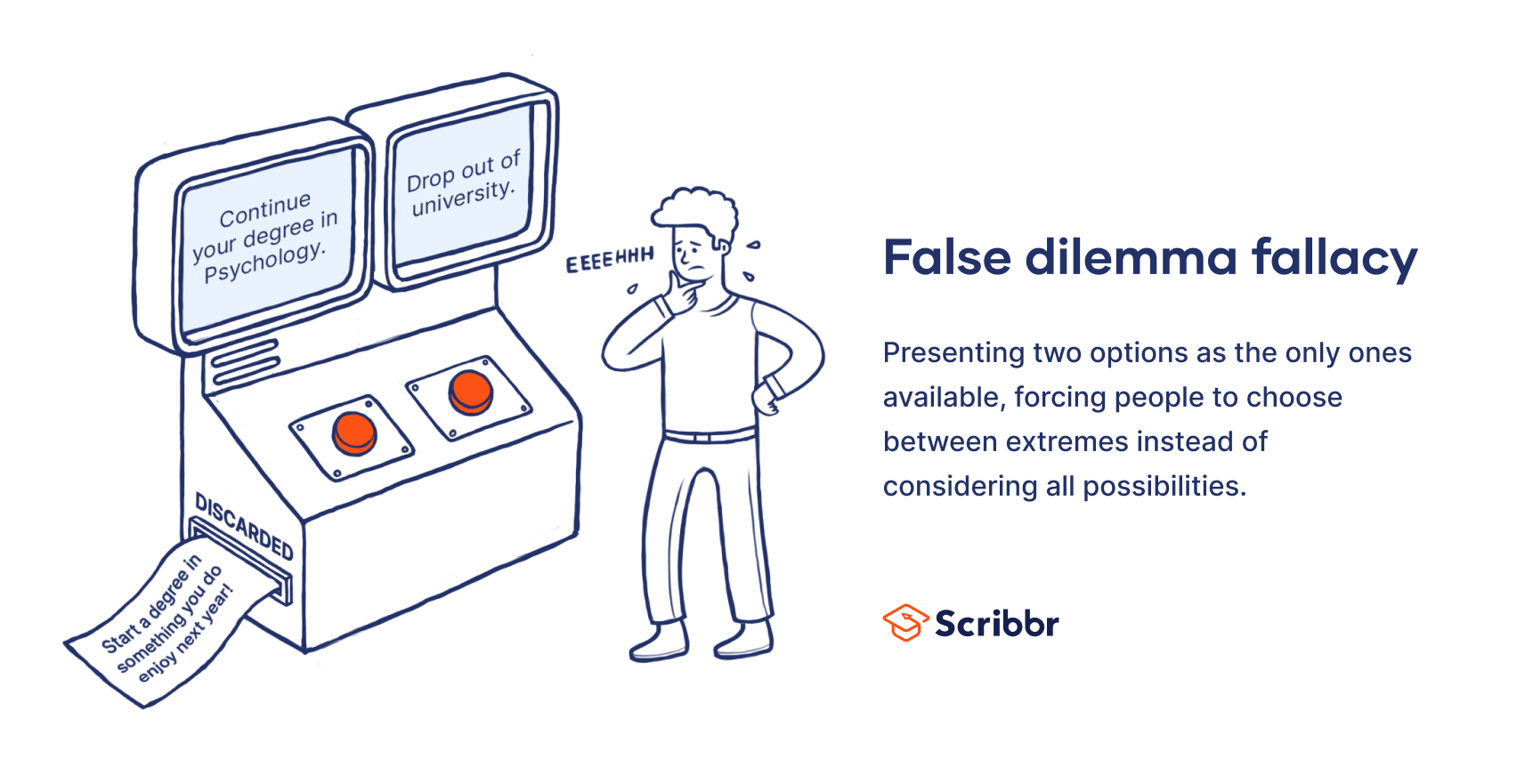False Dilemma Fallacy | Examples & Definition
The false dilemma fallacy involves presenting a limited number of options as if they were the only options available. This forces people to choose between two extremes, even though there is a spectrum of possibilities in between. The fallacy is misleading and prevents honest debate.
A false dilemma (or false dichotomy) is a common type of fallacy. It often appears in political speeches and advertisements, as well as informal everyday conversations.
What is the false dilemma fallacy?
The false dilemma fallacy occurs when someone misrepresents an issue by offering only two options (when more exist) or by presenting the options as mutually exclusive (when they are not).
In the example above, supporting the new law or accepting chaos are presented as the only options available, while the middle ground is being ignored (i.e., one may not want society to descend into chaos but may also be concerned about human rights).
The false dilemma is an informal logical fallacy. In other words, the form of the argument is logical: it’s possible to use an “either-or” format to express a truthful argument. What is problematic is the content of the premise – specifically, the assumption that out of the options being presented, only one must be true or can be picked.
In situations where more than one option exists, this is an oversimplification: it hides the fact that multiple propositions can be true at the same time or that other possibilities, which are hidden, can also be true.
Why does the false dilemma fallacy occur?
The false dilemma fallacy often occurs unintentionally due to our inherent need to simplify the world around us. The frequent use of either-or statements, which is already built into our language, reflects our desire to limit our choices and create clear distinctions even in the face of complex or fluid situations.
Sometimes, people intentionally present others with false dilemmas, especially in the political and social spheres. It is a way to manipulate an audience by presenting a limited set of options and withholding alternative choices. The choices presented divert the audience’s attention away from the other choices and push them to make the “right” choice.
The use of divisive language, such as “you’re either with us or against us”, is an example of how false dilemmas can be used to coerce listeners into accepting the speaker’s position.
Why is false dilemma fallacy a problem?
At an individual level, false dilemmas often arise in our internal reasoning process. This relates to black-and-white thinking or the tendency to think in absolutes (e.g., think you are either always right or the world’s biggest failure). It is a thought pattern that causes us to misunderstand situations and influences the decisions we make.
When used as a rhetorical device to persuade others, a false dilemma is highly misleading because it distorts the issue at hand and gives the wrong impression about the options available. By doing so, the false dilemma prevents people from drawing their own conclusions and manipulates them into accepting one position – since the alternative is always framed negatively.
False dilemma fallacy examples
False dilemma fallacy is often used as a persuasion technique in advertising to highlight that a specific product or service is the only reasonable choice.
In an effort to persuade consumers that their company was the only option for those looking for reputable movers, a United Van Lines TV commercial asked the following questions:
- a) A seamless professional move? or b) Your possessions set on fire?
- a) Technology experts to set up your home network? or b) Raccoons to run amok with your electronics?
- a) Portable containers to move yourself? or b) Complete chaos?
If you answered A, call United.
Surely, there must be other options apart from United Van Lines and raccoons, but the comic effect created with the false dilemma fallacy brings across the point (that United are the best movers).
Hiding the middle ground can have serious consequences, especially in politics, where people are often coerced to choose between extremes.
For example, during the COVID-19 pandemic, there were heated discussions in the US regarding the best way to handle this unprecedented health crisis. The use of the false dilemma steered public discourse in a particular direction by presenting it as a choice “between the loss of our way of life … and the loss of life”, as one Congressman put it.
By portraying the choice in “either-or” terms, politicians tried to persuade citizens that lockdowns and restrictions on large-scale gatherings were unacceptable, despite evidence that they significantly lowered transmission of the virus in Europe.
Other interesting articles
If you want to know more about fallacies, research bias, or AI tools, make sure to check out some of our other articles with explanations and examples.
AI tools
Fallacies
Frequently asked questions about the false dilemma fallacy
Cite this Scribbr article
If you want to cite this source, you can copy and paste the citation or click the ‘Cite this Scribbr article’ button to automatically add the citation to our free Reference Generator.
Nikolopoulou, K. (2023, June 26). False Dilemma Fallacy | Examples & Definition. Scribbr. Retrieved 23 June 2025, from https://www.scribbr.co.uk/fallacy/false-dilemma/




